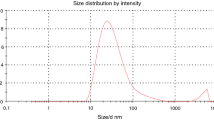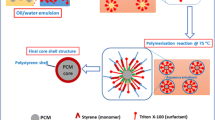Abstract
In this study, a mixture of nano-encapsulated phase change materials in water has been used as the working fluid in a pulsating heat pipe in order to investigate its thermal performance. The results of the experiments showed that using the nano-encapsulated paraffin dispersed in water as working fluid improves heat transfer and decreases the thermal resistance of the pulsating heat pipe. On the other hand, among the tested concentrations for nano-encapsulated paraffin, there is an optimal value in which increasing the concentration causes an increase in the thermal resistance of the pulsating heat pipe due to the increased dynamic viscosity of the fluid. Enhancement in the thermal performance of the pulsating heat pipe by adding paraffin nanocapsules is attributed to the increase in effective specific heat of the fluid mixture as a result of the latent heat of paraffin nanocapsules. Higher effective sensible heat leads to an augmentation of convective heat transfer which has the main role in heat transfer of heat pipes. Moreover, the existence of nano-encapsulated paraffin can result in more mixing which is another reason for heat transfer enhancement. In addition, the use of nano-encapsulated phase change paraffin at high concentrations causes a cessation in the dry-out phenomenon at higher heat input compared with water or, in other words, increases the operating range of the pulsating heat pipe, which is due to an increase in the heat capacity of the fluid. In addition, the effect of inclination angle (30°, 60°, and 90°) on the thermal performance of the PHP at an optimum concentration among tested concentrations of nano-encapsulated paraffin was investigated, which was equal to 6.25 g L−1. It was observed that the PHP had its best thermal performance at the vertical position. The lowest measured thermal resistance of the PHP was 0.86 K W−1 in a vertical orientation and 50 W heat input. Moreover, at 30°, the thermal resistance of the PHP sharply increased, which can be attributed to the reduced effect of gravity in fluid return from the condenser to the evaporator. The maximum thermal resistance of the PHP observed in the case of inclination angle equal to 30° and 10 W heat input was 5.38 K W−1.












Similar content being viewed by others
Abbreviations
- K :
-
Thermal conductivity (W m−1 K−1)
- L :
-
Length (m)
- \(\dot{Q}\) :
-
Thermal power (W)
- R :
-
Thermal resistance (K W−1)
- T :
-
Temperature (K)
- \(\tau\) :
-
Heat transfer improvement rate (%)
- Ce:
-
Core content (%)
- ΔH :
-
Enthalpy of melting for nanocapsules (J g−1)
- a:
-
Adiabatic
- c:
-
Condensing
- e:
-
Evaporator
- eff:
-
Effective
References
Ramezanizadeh M, Alhuyi Nazari M, Ahmadi MH, Açıkkalp E. Application of nanofluids in thermosyphons: a review. J Mol Liq. 2018;272:395–402. https://doi.org/10.1016/J.MOLLIQ.2018.09.101.
Faegh M, Shafii MB. Experimental investigation of a solar still equipped with an external heat storage system using phase change materials and heat pipes. Desalination. 2017;409:128–35. https://doi.org/10.1016/j.desal.2017.01.023.
Arab M, Soltanieh M, Shafii MB. Experimental investigation of extra-long pulsating heat pipe application in solar water heaters. Exp Therm Fluid Sci. 2012;42:6–15. https://doi.org/10.1016/j.expthermflusci.2012.03.006.
Haghighi Bardineh Y, Mohamadian F, Ahmadi MH, Akbarianrad N. Medical and dental applications of renewable energy systems. Int J Low Carbon Technol. 2018. https://doi.org/10.1093/ijlct/cty040.
Akbari A, Saidi MH. Experimental investigation of nanofluid stability on thermal performance and flow regimes in pulsating heat pipe. J Therm Anal Calorim. 2018. https://doi.org/10.1007/s10973-018-7388-3.
Alhuyi Nazari M, Ahmadi MH, Ghasempour R, Shafii MB. How to improve the thermal performance of pulsating heat pipes: a review on working fluid. Renew Sustain Energy Rev. 2018;91:630–8. https://doi.org/10.1016/j.rser.2018.04.042.
Ahmadi MH, Ahmadi MA, Nazari MA, Mahian O, Ghasempour R. A proposed model to predict thermal conductivity ratio of Al2O3/EG nanofluid by applying least squares support vector machine (LSSVM) and genetic algorithm as a connectionist approach. J Therm Anal Calorim. 2018. https://doi.org/10.1007/s10973-018-7035-z.
Hemmat Esfe M, Abbasian Arani AA, Shafiei Badi R, Rejvani M. ANN modeling, cost performance and sensitivity analyzing of thermal conductivity of DWCNT–SiO2/EG hybrid nanofluid for higher heat transfer. J Therm Anal Calorim. 2018;131:2381–93. https://doi.org/10.1007/s10973-017-6744-z.
Mahdavi M, Sharifpur M, Ahmadi MH, Meyer JP. Aggregation study of Brownian nanoparticles in convective phenomena. J Therm Anal Calorim. 2018. https://doi.org/10.1007/s10973-018-7283-y.
Baghban A, Pourfayaz F, Ahmadi MH, Kasaeian A, Pourkiaei SM, Lorenzini G. Connectionist intelligent model estimates of convective heat transfer coefficient of nanofluids in circular cross-sectional channels. J Therm Anal Calorim. 2018;132:1213–39. https://doi.org/10.1007/s10973-017-6886-z.
Mohamadian F, Eftekhar L, Haghighi Bardineh Y. Applying GMDH artificial neural network to predict dynamic viscosity of an antimicrobial nanofluid. Nanomed J. 2018;5:217–21. https://doi.org/10.22038/NMJ.2018.05.00005.
Behi H, Ghanbarpour M, Behi M. Investigation of PCM-assisted heat pipe for electronic cooling. Appl Therm Eng. 2017;127:1132–42. https://doi.org/10.1016/J.APPLTHERMALENG.2017.08.109.
Shafii MB, Ahmadi H, Faegh M. Experimental investigation of a novel magnetically variable conductance thermosyphon heat pipe. Appl Therm Eng. 2017;126:1–8. https://doi.org/10.1016/J.APPLTHERMALENG.2017.07.140.
Ando M, Okamoto A, Tanaka K, Maeda M, Sugita H, Daimaru T, et al. On-orbit demonstration of oscillating heat pipe with check valves for space application. Appl Therm Eng. 2018;130:552–60. https://doi.org/10.1016/J.APPLTHERMALENG.2017.11.032.
Mahfoud M, Emadi D. Application of heat pipe technology in thermal analysis of metals. J Therm Anal Calorim. 2005;81:161–7. https://doi.org/10.1007/s10973-005-0762-y.
Mohammadi M, Taslimifar M, Haghayegh S, Hannani SK, Shafii MB, Saidi MH, et al. Open-loop pulsating heat pipes charged with magnetic nanofluids: powerful candidates for future electronic coolers. Nanoscale Microscale Thermophys Eng. 2014;18:18–38. https://doi.org/10.1080/15567265.2013.787570.
Mohammadi M, Mohammadi M, Ghahremani AR, Shafii MB, Mohammadi N. Experimental investigation of thermal resistance of a ferrofluidic closed-loop pulsating heat pipe. Heat Transf Eng. 2014;35:25–33. https://doi.org/10.1080/01457632.2013.810086.
Mameli M, Manno V, Filippeschi S, Marengo M. Thermal instability of a closed loop pulsating heat pipe: combined effect of orientation and filling ratio. Exp Therm Fluid Sci. 2014;59:222–9. https://doi.org/10.1016/j.expthermflusci.2014.04.009.
Wang J, Ma H, Zhu Q, Dong Y, Yue K. Numerical and experimental investigation of pulsating heat pipes with corrugated configuration. Appl Therm Eng. 2016;102:158–66. https://doi.org/10.1016/J.APPLTHERMALENG.2016.03.163.
Liang Q, Li Y, Wang Q. Experimental investigation on the performance of a neon cryogenic oscillating heat pipe. Cryogenics (Guildf). 2017;84:7–12. https://doi.org/10.1016/J.CRYOGENICS.2017.03.004.
Gandomkar A, Saidi MH, Shafii MB, Vandadi M, Kalan K. Visualization and comparative investigations of pulsating ferro-fluid heat pipe. Appl Therm Eng. 2017;116:56–65. https://doi.org/10.1016/J.APPLTHERMALENG.2017.01.068.
Taslimifar M, Mohammadi M, Afshin H, Saidi MH, Shafii MB. Overall thermal performance of ferrofluidic open loop pulsating heat pipes: an experimental approach. Int J Therm Sci. 2013;65:234–41. https://doi.org/10.1016/j.ijthermalsci.2012.10.016.
Jamshidi H, Arabnejad S, Shafii MB, Saboohi Y. Thermal characteristics of closed loop pulsating heat pipe with nanofluids. J Enhanc Heat Transf. 2011;18:221–37. https://doi.org/10.1615/JEnhHeatTransf.v18.i3.40.
Ebrahimi M, Shafii MB, Bijarchi MA. Experimental investigation of the thermal management of flat-plate closed-loop pulsating heat pipes with interconnecting channels. Appl Therm Eng. 2015;90:838–47. https://doi.org/10.1016/J.APPLTHERMALENG.2015.07.040.
Tseng C-Y, Yang K-S, Chien K-H, Jeng M-S, Wang C-C. Investigation of the performance of pulsating heat pipe subject to uniform/alternating tube diameters. Exp Therm Fluid Sci. 2014;54:85–92. https://doi.org/10.1016/J.EXPTHERMFLUSCI.2014.01.019.
Lenin R, Joy PA. Role of base fluid on the thermal conductivity of oleic acid coated magnetite nanofluids. Colloids Surfaces A Physicochem Eng Asp. 2017;529:922–9. https://doi.org/10.1016/J.COLSURFA.2017.06.084.
Ahmadi MH, Alhuyi Nazari M, Ghasempour R, Madah H, Shafii MB, Ahmadi MA. Thermal conductivity ratio prediction of Al2O3/water nanofluid by applying connectionist methods. Colloids Surfaces A Physicochem Eng Asp. 2018;541:154–64. https://doi.org/10.1016/J.COLSURFA.2018.01.030.
Nazari MA, Ghasempour R, Ahmadi MH, Heydarian G, Shafii MB. Experimental investigation of graphene oxide nanofluid on heat transfer enhancement of pulsating heat pipe. Int Commun Heat Mass Transf. 2018;91:90–4. https://doi.org/10.1016/j.icheatmasstransfer.2017.12.006.
Mohammadi M, Mohammadi M, Shafii MB. Experimental investigation of a pulsating heat pipe using ferrofluid (magnetic nanofluid). J Heat Transfer. 2012;134:014504. https://doi.org/10.1115/1.4004805.
Sedighi E, Amarloo A, Shafii B. International Journal of Heat and Mass Transfer Numerical and experimental investigation of flat-plate pulsating heat pipes with extra branches in the evaporator section. Int J Heat Mass Transf. 2018;126:431–41. https://doi.org/10.1016/j.ijheatmasstransfer.2018.05.047.
Shirin-Abadi AR. Preparation and characterization of nanocapsules containing phase change materials through miniemulsion polymerization and study of their thermal properties. Tehran: University of Tehran; 2011.
Shirin-Abadi AR, Mahdavian AR, Khoee S. New approach for the elucidation of PCM nanocapsules through miniemulsion polymerization with an acrylic shell. Macromolecules. 2011;44:7405–14. https://doi.org/10.1021/ma201509d.
Shirin-Abadi AR, Khoee S, Rahim-Abadi MM, Mahdavian AR. Kinetic and thermodynamic correlation for prediction of morphology of nanocapsules with hydrophobic core via miniemulsion polymerization. Colloids Surfaces A Physicochem Eng Asp. 2014;462:18–26. https://doi.org/10.1016/J.COLSURFA.2014.08.009.
Shafii MB, Faghri A, Zhang Y. Analysis of heat transfer in unlooped and looped pulsating heat pipes. Int J Numer Methods Heat Fluid Flow. 2002;12:585–609. https://doi.org/10.1108/09615530210434304.
Shafii MB, Arabnejad S, Saboohi Y, Jamshidi H. Experimental investigation of pulsating heat pipes and a proposed correlation. Heat Transf Eng. 2010;31:854–61. https://doi.org/10.1080/01457630903547636.
Lotfi H, Shafii MB. Boiling heat transfer on a high temperature silver sphere in nanofluid. Int J Therm Sci. 2009;48:2215–20. https://doi.org/10.1016/J.IJTHERMALSCI.2009.04.009.
Alizadeh H, Ghasempour R, Razi Astaraei F, Alhuyi Nazari M. Numerical modeling of PV cooling by using pulsating heat pipe. In: 3rd international conference on exhibition on solar energy ICESE-2016, Tehran; 2016.
Wu Q, Xu R, Wang R, Li Y. Effect of C60 nanofluid on the thermal performance of a flat-plate pulsating heat pipe. Int J Heat Mass Transf. 2016;100:892–8. https://doi.org/10.1016/J.IJHEATMASSTRANSFER.2016.05.008.
Acknowledgements
The authors would like to express their gratitude to the Deputy for Research and Technology of Sharif University of Technology for supporting this research study.
Author information
Authors and Affiliations
Corresponding author
Additional information
Publisher's Note
Springer Nature remains neutral with regard to jurisdictional claims in published maps and institutional affiliations.
Rights and permissions
About this article
Cite this article
Heydarian, R., Shafii, M.B., Rezaee Shirin-Abadi, A. et al. Experimental investigation of paraffin nano-encapsulated phase change material on heat transfer enhancement of pulsating heat pipe. J Therm Anal Calorim 137, 1603–1613 (2019). https://doi.org/10.1007/s10973-019-08062-6
Received:
Accepted:
Published:
Issue Date:
DOI: https://doi.org/10.1007/s10973-019-08062-6




